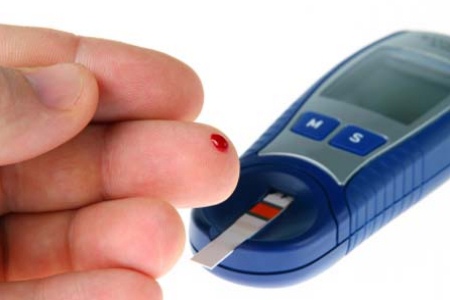Diabetes commonly refers to a disease in which a person’s blood sugar levels are high. It is derived from a Greek word that refers to a siphon through which water passes. The term diabetes refers to a condition where lot of urine is passed. There are two conditions where patients pass a lot of urine and the word diabetes is used. One is diabetes mellitus in which blood sugar is high and the other is diabetes insipidus where the excess urine has nothing to do with high blood sugar. In this article, the word diabetes will refer to diabetes mellitus only. Diabetes can occur at any age. The type of diabetes that starts in childhood is often quite different from the diabetes that starts after the age of 30 years. Childhood diabetes is often Type 1 diabetes while adult diabetes is often Type 2 diabetes. Diabetes may itself through symptoms like excess thirst, fatigue and passing a lot of urine but one should not depend on symptoms alone to suspect diabetes. All people above the age of 40 years old should check their blood sugar levels annually to detect diabetes before it causes symptoms.  What is the difference between Type 1 and Type 2 diabetes? This is something that all people who have diabetes must know. In Type 1 diabetes there is absolutely no insulin in the body, whereas in Type 2 diabetes there is a good amount of insulin still available in the body. Type 1 diabetes can never be controlled by tablets and will need insulin treatment. Insulin can only be given by injection. People with diabetes – boys, girls, men and women – are often averse to daily injections and may insist that they wish to try tablets because they have seen other people being treated with tablets. However, if they have Type 1 diabetes, treatment with tablets will not work and doing so is an invitation for future complications. Fortunately most people who suffer from diabetes have Type 2 diabetes which can be treated with tablets, at least for many years. Why is everyone afraid of diabetes? We are worried about diabetes because high blood sugar insidiously damages our cells and tissues. Even though people associate diabetes with passing excessive urine or being excessively thirsty, many adults with diabetes have no symptoms and are surprised to know that they have diabetes when their blood is tested. So do not depend on symptoms as a reliable way to determine if you have diabetes or not.
What is the difference between Type 1 and Type 2 diabetes? This is something that all people who have diabetes must know. In Type 1 diabetes there is absolutely no insulin in the body, whereas in Type 2 diabetes there is a good amount of insulin still available in the body. Type 1 diabetes can never be controlled by tablets and will need insulin treatment. Insulin can only be given by injection. People with diabetes – boys, girls, men and women – are often averse to daily injections and may insist that they wish to try tablets because they have seen other people being treated with tablets. However, if they have Type 1 diabetes, treatment with tablets will not work and doing so is an invitation for future complications. Fortunately most people who suffer from diabetes have Type 2 diabetes which can be treated with tablets, at least for many years. Why is everyone afraid of diabetes? We are worried about diabetes because high blood sugar insidiously damages our cells and tissues. Even though people associate diabetes with passing excessive urine or being excessively thirsty, many adults with diabetes have no symptoms and are surprised to know that they have diabetes when their blood is tested. So do not depend on symptoms as a reliable way to determine if you have diabetes or not.
Uncontrolled diabetes damages the eyes and causes blindness, damages the kidneys and makes dialysis or kidney transplants necessary. It damages the nerves and gives rise to pain in the limbs and to wounds that do not easily heal. Furthermore, by encouraging damage to the lining of blood vessels, diabetes makes a person more susceptible to heart attacks and strokes.
If I have diabetes, what should I know in order to prevent complications? There are a few things that you can do to ensure that complications from diabetes do not develop. 1. Be aware of your blood sugar level. The number to remember is 7. Your fasting blood sugar, and blood sugar before lunch and dinner, should always be below 7mmol/L. The glycosylated hemoglobin or HbA1c, a test to measure the average of your blood sugar levels over the previous three months, should be below 7 percent. If the blood sugar level is higher than 7, you need to consult your doctor.
There are a number of reasons why blood sugar is not controlled well. It may be because your diet includes too many calories from sugars and carbohydrates; your medicines are not adequate; or you are not exercising enough.
2. Check your blood pressure and make sure that is below 130/80mm Hg. High blood pressure plus high blood sugar is a dangerous combination for the heart and brain. You need to take appropriate measures to control your blood pressure. This often involves reducing salt in the diet, exercising and taking blood pressure – lowering tablets if needed. 3. Check your cholesterol and triglyceride levels and make sure that they are not high. 4. Keep your body weight within normal. One way to know whether your body weight is normal is to do a simple calculation where you divide your weight (kg) by the square of your height (in meters). If this ratio is around 23, your body weight is fine. 5. Do aerobic exercises for a minimum of 30 minutes a day on at least five days a week. Aerobic exercises improve circulation and oxygen delivery to tissues and organs in the body. It is very important for maintaining good health.  Special issues in women High blood sugar is bad for women who are pregnant because it damages the cells and tissues of the developing baby. It also invites complications to the health of the mother. Women with diabetes who intend to have babies should ensure that their blood sugars are normal before they become pregnant. Those women who are not known to be diabetic should test their blood sugar levels as soon as their pregnancies are confirmed. Pregnant women with diabetes should remember that it is safer for them to be receive insulin injections for controlling blood sugar during their pregnancy. The tablets that are used for treating diabetes may be harmful for the developing fetus in the mother’s womb. Prepared by: Dr Velayudhan Menon, MD. Clinical Associate Professor in Internal Medicine, International Medical University
Special issues in women High blood sugar is bad for women who are pregnant because it damages the cells and tissues of the developing baby. It also invites complications to the health of the mother. Women with diabetes who intend to have babies should ensure that their blood sugars are normal before they become pregnant. Those women who are not known to be diabetic should test their blood sugar levels as soon as their pregnancies are confirmed. Pregnant women with diabetes should remember that it is safer for them to be receive insulin injections for controlling blood sugar during their pregnancy. The tablets that are used for treating diabetes may be harmful for the developing fetus in the mother’s womb. Prepared by: Dr Velayudhan Menon, MD. Clinical Associate Professor in Internal Medicine, International Medical University









